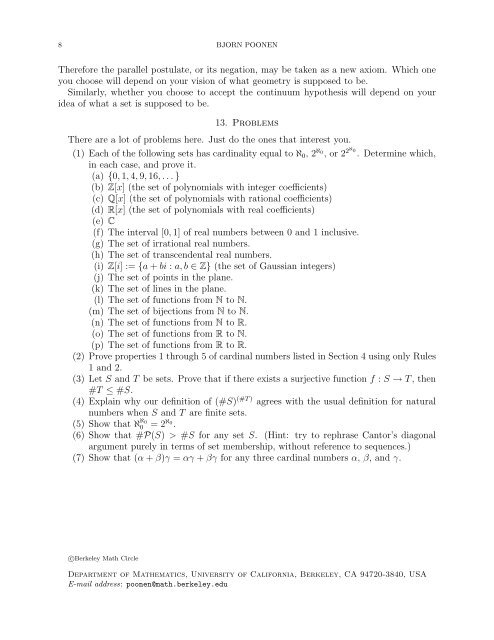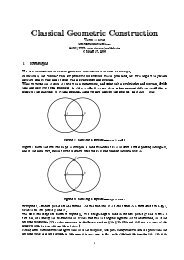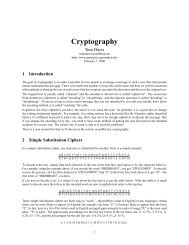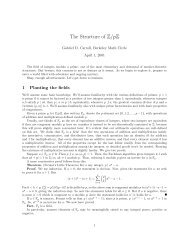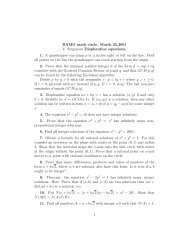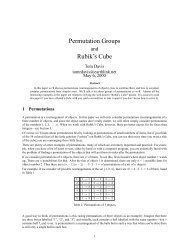INFINITY: CARDINAL NUMBERS 1. Some terminology of set theory ...
INFINITY: CARDINAL NUMBERS 1. Some terminology of set theory ...
INFINITY: CARDINAL NUMBERS 1. Some terminology of set theory ...
Create successful ePaper yourself
Turn your PDF publications into a flip-book with our unique Google optimized e-Paper software.
8 BJORN POONEN<br />
Therefore the parallel postulate, or its negation, may be taken as a new axiom. Which one<br />
you choose will depend on your vision <strong>of</strong> what geometry is supposed to be.<br />
Similarly, whether you choose to accept the continuum hypothesis will depend on your<br />
idea <strong>of</strong> what a <strong>set</strong> is supposed to be.<br />
13. Problems<br />
There are a lot <strong>of</strong> problems here. Just do the ones that interest you.<br />
(1) Each <strong>of</strong> the following <strong>set</strong>s has cardinality equal to ℵ0, 2 ℵ0 , or 2 2 ℵ 0 . Determine which,<br />
in each case, and prove it.<br />
(a) {0, 1, 4, 9, 16, . . . }<br />
(b) Z[x] (the <strong>set</strong> <strong>of</strong> polynomials with integer coefficients)<br />
(c) Q[x] (the <strong>set</strong> <strong>of</strong> polynomials with rational coefficients)<br />
(d) R[x] (the <strong>set</strong> <strong>of</strong> polynomials with real coefficients)<br />
(e) C<br />
(f) The interval [0, 1] <strong>of</strong> real numbers between 0 and 1 inclusive.<br />
(g) The <strong>set</strong> <strong>of</strong> irrational real numbers.<br />
(h) The <strong>set</strong> <strong>of</strong> transcendental real numbers.<br />
(i) Z[i] := {a + bi : a, b ∈ Z} (the <strong>set</strong> <strong>of</strong> Gaussian integers)<br />
(j) The <strong>set</strong> <strong>of</strong> points in the plane.<br />
(k) The <strong>set</strong> <strong>of</strong> lines in the plane.<br />
(l) The <strong>set</strong> <strong>of</strong> functions from N to N.<br />
(m) The <strong>set</strong> <strong>of</strong> bijections from N to N.<br />
(n) The <strong>set</strong> <strong>of</strong> functions from N to R.<br />
(o) The <strong>set</strong> <strong>of</strong> functions from R to N.<br />
(p) The <strong>set</strong> <strong>of</strong> functions from R to R.<br />
(2) Prove properties 1 through 5 <strong>of</strong> cardinal numbers listed in Section 4 using only Rules<br />
1 and 2.<br />
(3) Let S and T be <strong>set</strong>s. Prove that if there exists a surjective function f : S → T , then<br />
#T ≤ #S.<br />
(4) Explain why our definition <strong>of</strong> (#S) (#T ) agrees with the usual definition for natural<br />
numbers when S and T are finite <strong>set</strong>s.<br />
(5) Show that ℵ ℵ0<br />
0 = 2 ℵ0 .<br />
(6) Show that #P(S) > #S for any <strong>set</strong> S. (Hint: try to rephrase Cantor’s diagonal<br />
argument purely in terms <strong>of</strong> <strong>set</strong> membership, without reference to sequences.)<br />
(7) Show that (α + β)γ = αγ + βγ for any three cardinal numbers α, β, and γ.<br />
c○Berkeley Math Circle<br />
Department <strong>of</strong> Mathematics, University <strong>of</strong> California, Berkeley, CA 94720-3840, USA<br />
E-mail address: poonen@math.berkeley.edu


